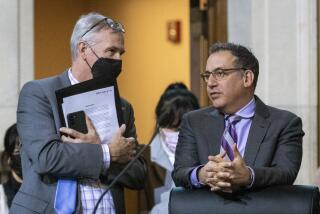As top Bell officials earned massive salaries, city workers were laid off

- Share via
At the same time that top Bell officials were receiving some of the fattest municipal salaries in the nation, the city cut spending on police, social services, and parks and recreation, according to interviews and records reviewed by The Times.
While City Manager Robert Rizzo was receiving more than $700,000 a year, Rosario Torres was laid off from her $9-an-hour job preparing children for kindergarten.
“They tell you they don’t have the money to pay you, and you think ‘OK, I understand, they just don’t have the money,’ ” Torres said. “But I never imagined they were making so much money themselves. It’s incredible.”
FULL COVERAGE: High salaries stir outrage in Bell
The cuts underscore questions about how Bell handled its finances in recent years. City officials have defended Rizzo’s high salary, saying his leadership allowed Bell to avoid many of the cuts and financial problems surrounding cities have faced amid the recession.
Rizzo told The Times earlier this month that Police Chief Randy Adams was brought in to turn around a department riddled with problems. The city had enough money to pay Adams $457,000 a year, yet it had earlier reduced funding for officer training, such as quarterly sessions at the firing range.
Details of the cuts came from interviews and from Bell’s Comprehensive Financial Report for fiscal year 2009, the latest available.
The report shows that community services, including social services and recreation programs, were cut by 21%, or $593,438, while public safety took a 3.7% hit, or $228,888. Police training was whacked by 58%.
The salaries of Rizzo, Adams and Assistant City Manager Angela Spaccia are equal to about 10% of Bell’s $15.9-million general fund budget.
The report provides a less rosy picture of Bell’s finances than the one city officials have offered in recent weeks. While Bell has a balanced budget, it has also faced significant belt-tightening.
Mayor Oscar Hernandez has defended Rizzo’s salary, citing “15 years of balanced budgets” and the transformation of Bell into a “model of financial prudence.”
Earlier this month, in an interview before the scandal broke, Hernandez, Rizzo and Councilman Luis Artiga boasted about the city’s services, parks and sound financial footing. Rizzo said that no full-time employees had been laid off and that there were no furloughs.
Gilbert Jara, head of the Bell Police Officers Assn., said the cuts included layoffs of some non-sworn employees, and have had other ill effects.
“Every year we are supposed to update our training,” Jara said. “It has now gotten down to where they give us a CD to watch and say, ‘OK, that’s your training.’ We watch a CD for three or four hours and that’s it.”
Officers are supposed to get quarterly firing-range training but “are lucky to get there once a year,” he said. Many of the department’s 24 authorized positions are left perennially unfilled, he said, and officers drive patrol cars “with like 200,000 miles on them.”
Jara said Adams seemed more interested in forming a multi-city police authority in southeast Los Angeles County than in fixing the department he was hired to run last July.
Bell officials’ high salaries, which include $376,288 a year for Spaccia and about $100,000 for all but one of the part-time City Council members, shocked city workers and just about everyone else in town when The Times reported the figures earlier this month.
The ensuing public outrage prompted the resignations last week of Rizzo, Adams and Spaccia, and sparked calls for the ouster of Hernandez and three of his fellow council members. Only Councilman Lorenzo Velez, who is paid a fraction of what his colleagues get, has eluded public scorn.
Rosario Torres said she wasn’t surprised when she was laid off in December 2008. The city had been axing workers and cutting programs for children and adults, she said.
Torres had been working in a Parks and Recreation program preparing children for kindergarten for about a year when she and several other part-timers were laid off.
“She said they just didn’t have the money to pay us,” Torres said. “There was no other explanation.”
Miguel Sanchez, 33, worked for Parks and Recreation from September 1994 to December 2008, when he and more than a dozen others were laid off due to budget cuts, he said.
Sanchez said he earned about $10.50 per hour. He wore several hats, teaching basic computer classes and working at the Bell Community Center on Pine Avenue, mostly on weekends if the space was being rented out for a birthday party or other event. Mostly, he ran an afterschool program at Woodlawn Elementary School.
Between 30 and 70 children attended the program depending on the time of year, he said, and were offered a variety of programs, including help with homework and arts and crafts.
Just before Christmas 2008, City Hall eliminated the program and two others. After he got laid off, a supervisor asked Sanchez to return to Woodlawn after the holidays to break the news to the children.
“I refused,” he said. “I didn’t have the heart to tell the kids.”
In 1984, the shoe company where Del Villanueva had worked for 20 years went bankrupt, forcing him into retirement at 60 — a little earlier than he had planned.
As the years passed, he got antsy and began volunteering for children’s programs and community centers in and around Bell, where he lived. In 2005, at the age of 80, he accepted a job at Bell City Hall to do maintenance at city parks and help run the afterschool program at Woodlawn.
The job paid a little over $9 an hour, but “there was a lot of satisfaction” and “parts of the job that were worth a lot more than money,” he said.
“It was very greatly needed,” he said. “You have to understand the basics. It’s a very important thing in a kid’s life.”
Like Sanchez, Villanueva lost his job when the program was cut.
About the same time, the city scaled back other recreation programs, including a baseball league and city-sponsored cheerleading program.
Carlos Parra, 43, said he took a squad of about 10 girls in 2000 and within eight years turned it into a thriving cheerleading program of about 160 boys and girls. The Bell Sapphires traveled from San Diego to Las Vegas and won championships for the city, Parra said.
On Christmas Day in 2008, Parra learned that he was to be laid off.
“It makes me sad, and mad,” he said. “I live alone, a single person, I have to pay my rent, I’m barely making it through life — and they’re sitting on their butt making all that money.”
Times staff writers Jeff Gottlieb and Paloma Esquivel contributed to this report.
More to Read
Sign up for Essential California
The most important California stories and recommendations in your inbox every morning.
You may occasionally receive promotional content from the Los Angeles Times.













